Renowned in years gone by as a winter snapper fishery, Corio Bay and the Bellarine Peninsula are fast gaining a reputation as a diverse sports fishery, all thanks to the modern range of soft plastic lures.
Although large snapper are still the major draw card, you can expect to encounter flathead, bream, trevally, salmon, whiting, snook/pike, squid and even kingfish for anglers in the know. It can be a real lottery at times, which is one of the reasons why fishing with lures and soft plastics is becoming increasingly popular.
Corio Bay is situated along the western shoreline of Port Phillip Bay and is roughly bounded by Point Wilson to the north, the city of Geelong to the west and the Bellarine Peninsula to the south.
Since moving to the Bellarine Peninsula three years ago, I’ve spent many hours fishing a variety of locations in and around the local area, particularly the sheltered waters of Geelong Harbour, Swan Bay and Queenscliff Harbour. Getting up to speed on soft plastics was initially frustrating, particularly when targeting bream and snapper. Although books, radio reports, magazine articles and local advice provided a starting point, things only started to fall into place once I dedicated more time to developing ‘my own’ local knowledge. There’s simply no substitute for local information.
As research for this article I also consulted some of the more experienced lure anglers in the region, who generously offered their knowledge and experience. John Didge, Andy Smith, Bill Hartshorne and Steve Stojanovski have more than 80 years of local fishing experience between them and I sincerely thank these guys for their contribution.
The following guide to fishing Corio Bay and the Bellarine Peninsula with lures and soft plastics covers the area from Point Wilson right through to Point Lonsdale.
John Didge is co-host and producer of The Fishing Show, which airs on 94.7 The Pulse every Saturday from 8-10am. He’s on the water most weeks and dedicates numerous hours to fishing Limeburners Bay, also known as the Grammar School Lagoon, for flathead, bream, trevally, pinkies, pike, salmon and whiting. Even though not renowned as a regular catch on lures, whiting are also a legitimate target around the weed beds off Avalon and Point Wilson.
In the Grammar School Lagoon, the fishing tends to be slow from June to August, but as the water temperature warms to 17-20oC during spring, baitfish are followed by flathead into the lagoon, while bream begin to school up at the mouth.
The middle few hours of either tide, during periods of peak flow, produce bigger than average flathead. They position themselves in ambush against the sand spit, weed beds and channel edges. Pinkie snapper also take up residence under the moored boats, mixing in with schools of bream and silver trevally during the warmer months.
An abundance of floating weed can make fishing with hard-bodied lures difficult at times, particularly in windy conditions, however light lines and small finesse soft plastics are very productive. John prefers the natural looking 65mm Squidgy Fish in the silver fox pattern for flathead and the Berkley Gulp 6” Sandworm or Atomic 2” Fat Grub for bream and trevally.
Andy Smith is a Berkley Pro Team member, freelance fishing journalist and is employed at Ray Long’s Tackle World in Geelong. He writes a weekly fishing column for the Geelong Independent newspaper and competes in the ABT and Victorian Bream Classic Series.
Although Andy enjoys a variety of sport fishing techniques, he spends most of his time fishing for snapper, bream and flathead with soft plastics in and around Corio Bay.
Structure and tidal flow is the key within the Geelong Harbour, with two hours either side of a changing tide providing the best results. The weed beds and rock ledges around North Shore draw large numbers of baitfish, which in turn attract predatory species including pinkie snapper, flathead, bream, trevally and pike.
Griffins Gully Jetty, Cunningham and Yarra Street piers and the Limeburners Rockwall are all favoured locations for land-based lure casting. Fish often school up close to the pier pylons and under the hulls of moored boats in the harbour and can be targeted with a variety of soft plastics.
Andy’s preferred lures are the Berkley Gulp range of minnows, worms and single-tail grubs in lime tiger, nuclear chicken, pumpkinseed and smelt, due to their extra scent and superior action. It pays to have a variety of jig-head styles and sizes in your tackle box, from 1/50oz to 1/8oz, with 1/16oz being a good starting point.
Bill Hartshorne grew up fishing the bay with his father before he moved away from Geelong in his early twenties to focus on freshwater flyfishing. Now that he has returned to the region he regularly targets snapper, trevally, salmon and squid on lures all throughout the Bellarine Peninsula.
Recently Bill has landed several large snapper up to 7kg from the spoilground between Point Henry and Clifton Springs. Early mornings coupled with a tide change and overcast conditions in water from 9-16ft deep have been the most productive.
Other top spots include the bend in the shipping channel off Clifton Springs, known as the Elbow, and the muscle beds and patches of weed directly out from the boat ramp.
Bill also prefers the Berkley Gulp range of minnows and single-tail grubs in nuclear chicken, smelt and pumpkinseed, matched to a 1/8oz jig-head in size 1 to 2/0.
Bill believes that large snapper are way too much fun to catch just once on light tackle and is an avid believer in catch and release. He prefers to target squid or flathead when he’s after a feed. Lately some large rock flathead up 60cm have been taken in this area.
Steve Stojanovski is co-owner of Firstcast Fishing Adventures and specialises in saltwater flyfishing and soft plastics for snapper, salmon, kingfish and sharks throughout Corio Bay, Bellarine Peninsula and Bass Strait.
Steve spends a lot of time fishing the shallows and has landed numerous snapper in excess of 5kg in just 8ft of water. The run-out tide is more productive and the prevailing southerly wind usually creates a little surface chop, which encourages fish to feed more aggressively in the shallows.
Use your sounder to help locate fish holding structure, particularly broken ground, rubble, weed beds and the edges of shipping channels. Sea anchors are a must to slow down your drift and to keep the boat facing the direction you are casting.
Steve is also an advocate of the Berkley Gulp range of soft plastics, particularly the 4” minnows in nuclear chicken, lime tiger, smelt and pumpkinseed.
He finds the biggest mistake anglers make when fishing with soft plastics is using jig-heads that are too heavy and working the lure too fast. He uses the lightest weight jig-head and smallest hook possible and tries to keep the lure in front of the fish for as long as he can. Often this can mean leaving the lure sitting motionless on the bottom for 30-60 seconds in between a series of short sharps hops and twitches.
The piers at Portarlington and St Leonards also provide good land-based opportunities for seasonal runs of snapper, salmon, whiting and squid.
Swan Bay is located between St Leonards and Queenscliff and although a large expanse of the bay is now Marine Park, fishing is permitted in the main channel between the yellow markers.
An electric motor is an advantage as it allows you to position the boat to the side of the main channel and cast lures into the shallows and work them back over the drop-off. If you don’t own an electric motor, simply drift with the current and cast ahead of the boat, rather than dragging the lure behind you.
As the tide changes and begins to run-out, trevally, pinkie snapper, flathead, snook, salmon, whiting and squid congregate along the edge of the weed beds to intercept baitfish, worms, shrimp and crabs that get washed off the flats. For land-based anglers, the area known as Lakers Cutting can produce some large bream on plastics and hard-bodied lures, but it is very shallow and must be fished during low light periods at dawn, dusk or heavy cloud cover.
The Queenscliff Harbour can turn on some fast and furious light tackle lure fishing for trevally, salmon and bream. The top of the high tide and first hour of the run-out tide produces the hottest bite in the main channel, while the low tide change seems to trigger the fish holding under the moored boats in the yacht club.
Squid are also available throughout the system but tend to be smaller and more difficult to catch than those encountered in the bay.
The Queenscliff and Point Lonsdale Piers are renowned locations for land-based squid and both can produce reasonable numbers of salmon from autumn through to spring.
Whilst reviewing the information sourced for this article, a number of common threads between the angler’s methods and the locations they fish became apparent.
The run-out tide is the most productive time to target fish on lures right throughout the region, particularly when fishing the shallows in water from 9-18ft deep. Overcast conditions are preferable and a light enough breeze to ripple the surface seems to settle the fish and provide more aggressive strikes.
Try to locate structure including broken ground, rubble, reef, weed beds, jetty pylons, moored boats and the edges of shipping channels and concentrate your efforts in the areas where bait fish are present.
Always use the lightest weight jig-head that will allow the lure to reach the bottom, while still enabling you to make a long cast.
You should also take into account the strength of the tide, depth of water, speed and direction of the wind, and the size of the plastic you intend to use. It pays to experiment with sizes, colours and styles on difficult days.
Why not start light tackle luring throughout Corio Bay and the Bellarine Peninsula right now?
Leave the bait behind and while you’re here, tune into the local fishing program, visit the local tackle store, book a guided fishing tour and when you’re ready for a real challenge, enter a bream tournament. It’s all at your fingertips!
Facts
LURES AND SOFT PLASTICS
Snapper and Flathead
Berkley Gulp 3” and 4” Minnows in nuclear chicken, lime tiger, smelt and pumpkinseed
Berkley Gulp 3” Minnow Grub in nuclear chicken, mango ripple glow, pumpkinseed and watermelon
Berkley Gulp 4” Turtleback Worm in pumpkinseed and watermelon
Squidgy Fish in black/gold and silver fox
Squidgy Wrigglers in bloodworm
Bream and Trevally
Berkley Gulp 6” Sandworm in camo
Berkley Gulp 4” Turtleback Worm in pumpkinseed and watermelon
Berkley Gulp 3” Craw in camo and pumpkinseed
Berkley Gulp 2” & 3” Shrimp in natural and lime tiger
Ecogear 1.5/2.5” Grass Minnow
Atomic 2” Fat Grub
River 2 Sea 35/43mm Baby Vibe
Ecogear SX40
Facts
BOAT RAMP MELWAY REFERENCES
| Avalon: | Page 11 |
|---|---|
| Limeburners Bay: | Page 11 |
| St Helens: | Map 442 B8 |
| Limeburners Point: | Map 452 H2 |
| Clifton Springs: | Map 456 E5 |
| Pt Richards: | Map 444 D5 |
| Portarlington: | Map 445 A5 |
| Indented Heads: | Map 446 C3 |
| St Leonards: | Map 460 B12 |
| Swan Bay: | Map 486 H1 |
| Queenscliff: | Map 486 K11 |
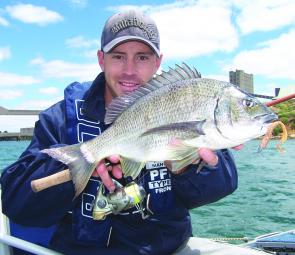
Brent Hodges with a bream from North Shore taken on a Berkley Gulp 4” Turtleback Worm in pumpkinseed.

Bill Hartshorne with a large snapper taken from the spoil ground near Point Henry on a Berkley Gulp 4” Minnow in nuclear chicken.
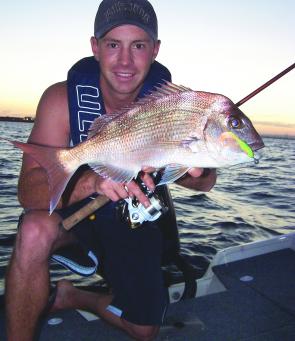
Brent Hodges with a pinkie snapper taken on a Berkley Gulp 3” Minnow Grub in mango ripple glow.
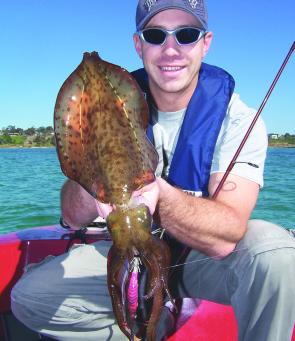
Brent Hodges with a squid caught on a Yozuri Squid jig from the weed beds off the Clifton Springs boat ramps.
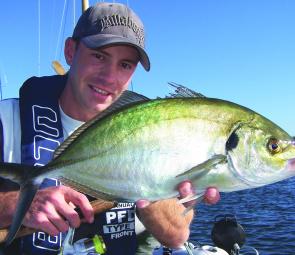
Brent Hodges with a trevally from Queenscliff Harbour taken on a River 2 Sea Mini Vibe.
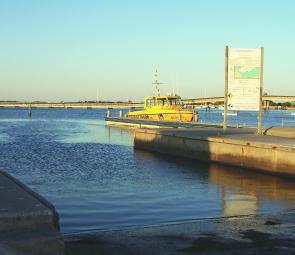
The Queenscliff Harbour can turn on some fast and furious light tackle lure fishing for trevally, salmon and bream.
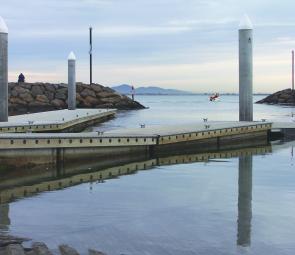
In Limeburners Bay, the fishing tends to be slow from June to August, but as the water temperature warms, flathead follow the baitfish into the lagoon and bream begin to school up at the mouth.




